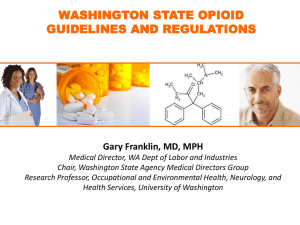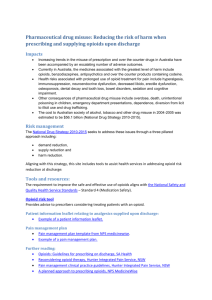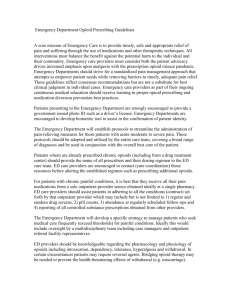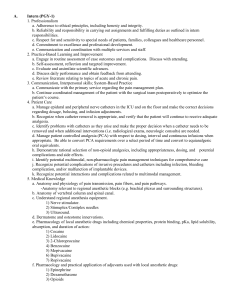On a scale of 0-10, how would you rate your pain? 4/27/2016
advertisement
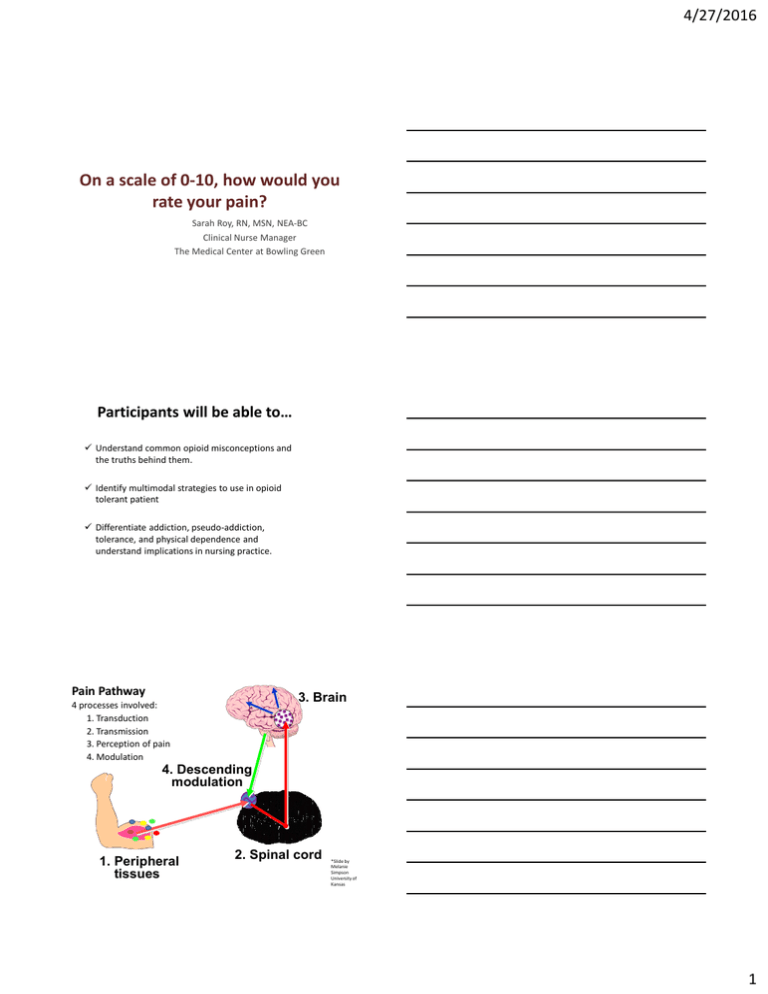
4/27/2016 On a scale of 0-10, how would you rate your pain? Sarah Roy, RN, MSN, NEA-BC Clinical Nurse Manager The Medical Center at Bowling Green Participants will be able to… Understand common opioid misconceptions and the truths behind them. Identify multimodal strategies to use in opioid tolerant patient Differentiate addiction, pseudo-addiction, tolerance, and physical dependence and understand implications in nursing practice. Pain Pathway 3. Brain 4 processes involved: 1. Transduction 2. Transmission 3. Perception of pain 4. Modulation 4. Descending modulation 1. Peripheral tissues 2. Spinal cord *Slide by Melanie Simpson University of Kansas 1 4/27/2016 Ascending pathway Descending pathway TCAs, SNRIs Anticonvulsants NSAIDS COX-2s Opioids Nerve Blocks Anticonvulsants Mechanism of Action of Selected Analgesics *Slide by Melanie Simpson University of Kansas Harmful Effects of Unrelieved Pain Endocrine INCREASED: ACTH, cortisol, ADH, epinephrine, norepinephrine, growth hormone, catecholamines, renin, angiotensin, aldosterone, glucagon, interleukin. DECREASED: insulin, testosterone Metabolic Gluconeogenesis, hepatic glycogenolysis, hyperglycemia, glucose intolerance, insulin resistance, muscle protein catabolism, increased lipolysis Cardiovascular INCREASED: HR, cardiac workload, PVR, SVR, HTN, coronary vascular resistance, myocardial oxygen consumption. Hypercoagulation, DVT Respiratory DECREASED: flows & volumes, cough. Atelectasis, shunting, hypoxemia, sputum retention, infection. Genitourinary DECREASED urinary output. Urinary retention, fluid overload, hypokalemia Gastrointestinal DECREASED gastric and bowel motility Musculoskeletal Muscle spasm, impaired muscle function, fatigue, immobility Cognitive Reduction in cognitive function, mental confusion Immune Depression of immune response Developmental INCREASED behavioral and physiologic responses to pain, altered temperaments, higher somatization, infant distress behavior; increased vulnerability to stress disorders, addictive behavior, and anxiety Future Pain Debilitating chronic pain syndromes: post mastectomy pain, post thoracotomy pain, phantom pain, post herpetic neuralgia Quality of Life Sleeplessness, anxiety, fear, hopelessness, increase thoughts of suicide VERSUS 2 4/27/2016 Molding VERSUS Research demonstrates that HCP expect to see certain behaviors in patients with pain Misconceptions about Opioids Opioids can only be prescribed so high then they lose their effectiveness. There is no ceiling for opioids, there is always room to increase, however the dose may be limited by side effects. Also, it’s very easy to increase opioids, it’s much more difficult to decrease opioids. Misconceptions about Opioids Visible signs, either physiological or behavioral, must accompany pain and can be used to verify it’s existence and severity. Pts live with pain everyday, body compensates. Depression is common, so may have flat affect. 3 4/27/2016 Misconceptions about Opioids IV opioids work better than PO opioids. IV opioids do not work better, they simply work faster. This is why equi-analgesic dosing is important, IV and PO medications can be equaled in strength. Misconceptions about Opioids There is no reason for patients to hurt when no physical cause for pain can be found. Takotsubo cardiomyopathy or “Broken Heart Syndrome” Stress-induced cardiomyopathy and acute heart failure. Majority of cases are caused by physical or emotional stressful event that preface the start of symptoms! All Guidelines Agree: Self Report is the Gold Standard of Pain Assessment! 4 4/27/2016 Seeking drugs? OR Seeking relief? Important Definitions Addiction: Chronic neurobiological disease- no single cause has been found. Loss of Control Compulsive use Continued use despite harm Craving Addiction: How to talk about it? • #1 Be Objective. • Non-judgmental attitude • Acknowledge • Open-ended questions • Listen with open ears • Foster open environment with the patient • Be direct in asking questions • Do not use parenting attitude • Encourage honesty for better care • Sometimes what’s right for the patient, isn’t 5 4/27/2016 Important Definitions Physical Dependence: Normal response that occurs with repeated administration of an opioid > 2 weeks. Withdrawal will occur if stopped abruptly Withdrawal will occur if Naloxone given Avoided through gradual reduction Important Definitions Tolerance: Normal response with regular administration, consists of decrease in 1+ effects Decrease in sedation Decrease in respiratory depression Decrease in analgesia Never tolerance to constipation **Stable pain usually results in stable doses Constipation • Most common side effect • NEVER develop a tolerance • Always use bowel regimen with any opioids 6 4/27/2016 TOLERANCE cannot be equated with ADDICTIVE DISEASE IMPORTANT DEFINITIONS Pseudo-addiction: Pts with undertreated pain may manifest behaviors similar to those of a typical addictive disease patient. Clock watching Multiple requests in between doses Escalating demands Obtaining opioids from others IMPORTANT DEFINITIONS • Direct consequence of inadequate pain management • Abnormal behaviors similar to those of addictive patients • Mistrust between patient and healthcare team • Distinguishable as behaviors resolve when pain is adequately treated 7 4/27/2016 Nursing assessment • Determine pain and medication baseline – Home medications? (ALWAYS verify before starting!) – Illicit drug use? (prescription or street) – Alcohol? – Coping mechanisms? • Set realistic goals with the patient – 0/10 may not be achievable – Daily pain score/activity level at home – Pain scores are not always appropriate • Any addiction issues at home? • Monitor for signs/symptoms of withdrawal What does withdrawal from opioids look like? • Agitation • Sweating • Anxiety/Restlessness • Diarrhea/ N&V • Rhinorrhea • Dilated pupils • Chills • Tachycardia • Generalized aches and pains • Abdominal cramping ***Not life-threatening like benzos/alcohol*** Nursing assessment post-operatively • Expect higher doses to be needed • Pre-operative dose does not equal postoperative dose • Extra monitoring may be needed • Avoid antagonist as much as possible– really sets patient back in pain control 8 4/27/2016 Principles to consider Post-operatively • Multi-modal strategies • Avoid gaps in analgesia – Around the clock dosing, long acting medications, pre-emptive offering • Pre-medicate before PT/OT, painful activities • Ideal is to get patient back to baseline medication dose after acute pain period over – Taper down Multi-Modal Approach • • • • • • • • Opioids NSAIDS, COX-2 Acetaminophen Local Anesthetics, Lidoderm Patch Muscle Relaxants, Benzodiazepines Anticonvulsants Antidepressants Non-pharm! Medication Routes 9 4/27/2016 Nursing Interventions • Ensure appropriate baseline medications are in place (ALWAYS verify first!) • Plan for appropriate timing of administration, don’t get behind • Ensure multi-modal approach • Create and implement pain plan with medical team, you, and patient • INDIVIDUALIZE CARE Equianalgesic dosing Opioid Equianalgesic Approximate Dose Morphine PO: 30mg, IV: 10mg Hydromorphone PO: 7.5mg, IV: 1.5mg Oxycodone PO: 30mg Fentanyl TD: 12mcg, IV: 100mcg Oxymorphone PO: 10mg Hydrocodone PO: 30mg Codeine PO: 200mg Dosing Guidelines • ATC (around-the-clock), Continuous dosing for persistent or chronic, immediate postop pain • PRN (as needed) dosing episodic pain, rescue/breakthrough 10 4/27/2016 Respiratory Status Pain Intensity Level of Sedation Age Underlying Pathology INDIVIDUALIZED THERAPY Other Meds Opioid Tolerance Chronic Pain Organ Function Kinetics Of Analgesia Diversion Activities • Offer various diversional activities – Help with boredom – Relaxation, guided imagery – Journaling – Puzzles, crafts, walk outside, converse – Helps the patient “escape” from the redundancy of the hospital setting Questions? 11 4/27/2016 References • American Pain Society. (2008). Principles of analgesic use in the treatment of acute pain and cancer pain. 6th ed. Skokie, IL: American Pain Society. • Colfer, Kathleen. (date). Acute Pain Management in the Opioid Tolerant Patient [PowerPoint slides]. Retrieved from http://www.aspmn.org/Conference/documents/KathleenColfer.pdf. • Martino, J., Roy, S., Royce, A. (2015). Pain Management Basics [Powerpoint slides]. • Pasero, C., McCaffery, M. (2011). Pain assessment and pharmacological management. St. Louis, Missouri: Mosby Elsevier. • Simpson, M. (2012). Pharmacology Lecture [PowerPoint Slides]. Retrieved from University of Kansas Medical Center. 12


